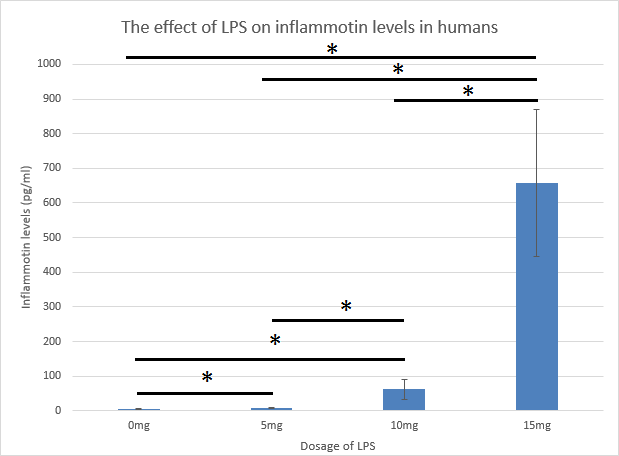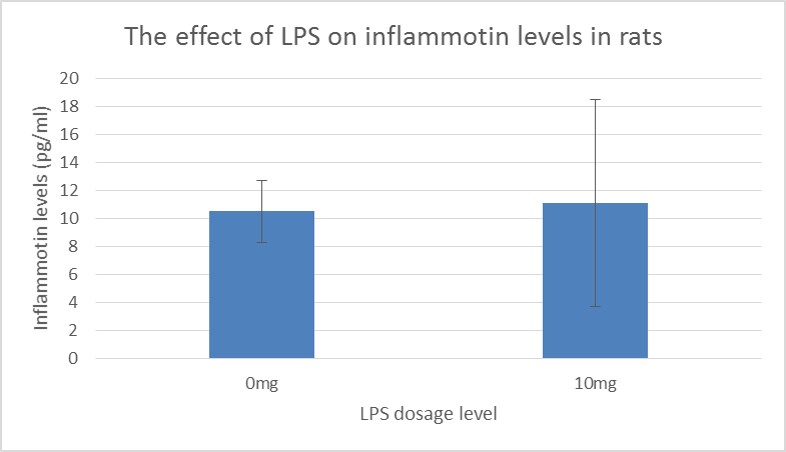BME100 f2013:W900 Group17 L2
| Home People Lab Write-Up 1 | Lab Write-Up 2 | Lab Write-Up 3 Lab Write-Up 4 | Lab Write-Up 5 | Lab Write-Up 6 Course Logistics For Instructors Photos Wiki Editing Help | ||||||
|
OUR TEAM
LAB 2 WRITE-UPDescriptive StatisticsLPS effects on Inflammotin levels in Humans For experiment 1 which involved human test subjects given differing levels of LPS in order to induce a positive change in inflammotin levels, the descriptive statistics were varied. For the control group that was not given any LPS, their average inflammotin level was 3.834 pg/ml with a standard deviation of 1.523010177 and standard error of 0.481618106. The group that was given 5ml of LPS had an average inflammotin level of 8.932 pg/ml with a standard deviation of 1.593931547 and a standard error of 0.504045412; the group that was given 10ml of LPS had an average inflammotin level of 61.122 pg/ml with a standard deviation of 30.11069386 and a standard error of 9.521837451, and the group that was given 15ml of LPS had an average inflammotin level of 657.941 pg/ml with a standard deviation of 212.9429762 and a standard error of 67.33848166. For each group the count was 10.
ResultsLPS effects on Inflammotin levels in Humans LPS effects on Inflammotin levels in Rats
AnalysisLPS effects on Inflammotin levels in Humans Since this experiment involved more than 2 groups, the ANOVA test was used, and it showed that the p-value was 1.40E-16, which signifies that the results were statistically significant. The post-hoc test, Bonferroni Correction, was applied to reinforce confidence in results. T-tests were completed for 6 comparisons: 0 to 5mg, 0 to 10mg, 0 to 15mg, 5 to 10mg, 5 to 15mg, and 10 to 15mg. The p-values of the 6 t-tests were, respectively, 8.60E10-7, 9.94E-6, 1.39E-8, 3.02E-5, 1.57E-8, and 6.48E-8. To adjust, the alpha-value of 0.05 is divided by the number of comparisons (6). This quotient ended up being higher than each of the p-values of the t-tests, signifying that the results are statistically significant. LPS effects on Inflammotin levels in Rats
In this experiment the t-test was used because two groups are involved. After the t-test was completed the p-value was calculated to be 0.86 which results in a 14 percent confidence level. The p-value has to be less than 0.05 to be considered significant but in this experiment the p-value was proven to be insignificant.(Using inferential statistics, please determine statistically significant differences in the data.)
Summary/DiscussionAs for the first experiment performed on human subjects, the bar graph showed that increase dosage of LPS increases levels of inflammotin. There was a statisically significant difference between 0 to 5mg as proved by the Bonferroni Correction, indicating that the low dosage of 5mg still makes a significant increase in inflammotin levels. Through statistical analysis, it was found that the difference between every amount of dosage were statistically significant. This shows that a slight increase of 5mg of LPS will significantly increase inflammotin levels. (For the second experiment performed on the rat subjects, it was found upon application of an unpaired t-test that the confidence level of there being a difference between the control group and the group given an amount of 10ml LPS was about 13.2597% with a p-value of .8674035, indicating that there is no significant difference between the groups because there was no statistical singificance indicated by the test.) Given the statistical analysis of the data, it could be concluded that there is no significant impact of LPS on inflammotin levels in rats with a dosage of 0 to 10 mg. However, when LPS was given to humans to test its effect on inflammotin levels, there was a significant difference between all dosages of LPS, as indicated by the Bonferroni Correction after an ANOVA test. Therefore, it could be inferred that humans are more sensitive to LPS than rats are. Perhaps a significant difference would have appeared in rats if they were given high dosages of LPS.
| ||||||


